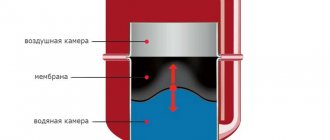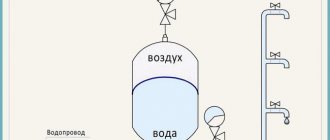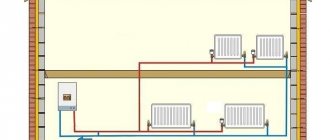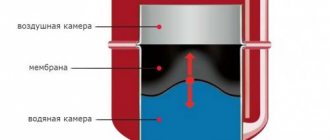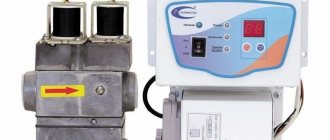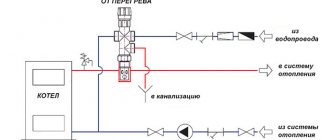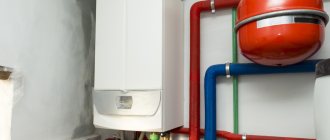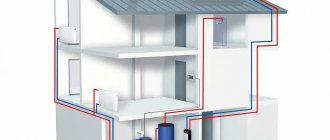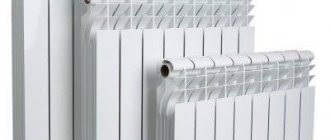Purpose and operational characteristics of the membrane expansion tank
When the coolant is heated, due to an increase in the volume of liquid, the pressure in the boilers and the heating system circuit increases. Since water is an incompressible medium and the system itself is sealed, this can lead to pipe or boiler failure
To solve the problem that arises, it is not enough to install a valve to squeeze out the excess volume of heated coolant, and here’s why: when cooled, the liquid will compress, and in its place air will certainly enter the circuit, which will interfere with the circulation of the coolant. Accordingly, the radiators will need to be constantly bleed and new coolant added, as a result of which heating water will be very expensive.
For this reason, a membrane expansion tank for heating is the optimal solution. Such a hydraulic accumulator is a reservoir connected to the heating system via a pipe. Excessive pressure in it is compensated by its volume; This ensures system safety and proper operation of the heating circuit. The expander takes in a certain amount of liquid as volume and pressure increase, and then, when these indicators decrease, returns it back. These devices differ from similar devices of other types in the following advantages:
- they can be successfully used in almost any water, in particular with a high calcium content;
- such tanks are allowed to be used for drinking water;
- they have a large useful displacement volume (compared to tanks without a membrane);
- pumping air into the expansion tank is required in a minimum amount;
- installation of the device is quick and does not require large expenses;
- the costs of operating and maintaining the device in working condition are minimal.
However, the expansion tank also has disadvantages. Sometimes during its installation problems arise due to the large size of the device: due to the fact that the liquid transfers heat to the hydraulic accumulator, heat loss may increase. To avoid uncontrolled heat loss, it is recommended to insulate the device.
There is also an increased risk of rust formation in such devices.
Expansion tank calculation
First, let's clarify the information a little: open-type expansion tanks (atmospheric) can also be installed on systems with forced circulation, this is the choice of the homeowner
We focused our attention on this, since it is unlikely that it will be possible to make a closed-type membrane tank at home, but an open one is no problem
But first you need to understand what dimensions it will have, and to do this, carry out the appropriate calculation. Without going into the jungle of formulas, we will use the old proven method of determining the capacity of the tank. Knowing that when heated from 20 ºС to 80 ºС, water adds approximately 4-5% in volume, let’s calculate the amount of water in the system. In this case, you should take into account:
- volume of the boiler tank - according to the manufacturer’s technical documentation;
- capacity of radiators - according to the product passport;
- the amount of coolant in the pipes.
Calculating the volume of water in pipes is quite simple. The lengths of all mains and connections are measured, distributed by diameter. Then the cross-sectional area of the pipe of each diameter is calculated and multiplied by its length. All results are added up and the total amount of water is obtained, to which the volume of coolant in the boiler and batteries is added.
Taking 5% of the total quantity and adding another 5% of the reserve, we determine that open-type expansion tanks should accommodate a tenth of what is in the system. Well, knowing the volume, it is not difficult to determine the size of the container.
Product design
Indoor heating systems can have open and closed circuits. The open scheme is used in centralized networks, so that when hot water is needed, it can be directly taken from the system. In this case, the expansion tank is placed at the top of the circuit in order not only to control the process of pressure drops, but also to separate air from the system. If the heating system is of a closed type, a design with a membrane inside is used.
The membrane type expansion tank has a relatively simple design. It includes a water reservoir and a rubber membrane, which can be a balloon or diaphragm type.
If the membrane is of the first type, then the coolant is located inside a rubber cylinder, outside of which there is nitrogen or air. This part can be easily replaced if necessary.
The diaphragm membrane for the expansion tank is a partition based on thin metal or elastic polymer. It has a small capacity and compensates for minor pressure differences, while being non-removable. If this part fails, it cannot be replaced, so the device will have to be replaced completely. However, compared to a balloon membrane, it is cheaper.
Design and types of expansion tank
Expansion tanks are available in open and closed types. The former have access to the atmosphere, while the latter do not. Open expanders are installed in circuits operating on the principle of natural circulation. Excess water simply flows out into the street or into the sewer, and the circuit is recharged after cooling manually through a make-up tap.
Closed expansion tank systems are most applicable in heating systems. Structurally, they consist of 2 chambers: water and air. Excess pressure is compensated in this way: excess coolant fills the water sector, creating pressure on the elastic membrane installed between the chambers. In this case, the air or a special gas filler available in the air sector is compressed. In contrast to water, it can be subjected to strong compression without increasing the pressure in the vessel.
There are two types sold in the retail chain, which are well integrated into the safety group for heating with an expansion tank:
- With a disc-type membrane;
- with a pear-shaped membrane.
Operating principle of a membrane type expansion tank
For each heating system, the gas pressure is adjusted to the specific volume of the expansion tank, according to the instructions for the device. You can use any type of membrane - this does not affect the efficiency of the accumulator. However, if it is of the balloon type, more heat-carrying liquid can be placed in the tank. The operating principle of the membrane expansion tank of the heating system does not differ for different types of structures and is as follows:
- due to the expansion of water, its pressure increases and the membrane stretches;
- when the membrane is stretched, excess coolant enters the accumulator;
- when the pressure in the network drops, the water cools and the coolant returns back to the heating system circuit.
The required pressure level is adjusted automatically.
Tank pressure
In some boilers (usually gas ones), the passport indicates what pressure must be set on the expander. If there is no such record, for normal operation of the system, the pressure in the tank should be 0.2-0.3 atm lower than the working one.
The heating system of a low-rise private house usually operates at 1.5-1.8 atm. Accordingly, there should be 1.2-1.6 atm in the tank. The pressure is measured with a conventional pressure gauge, which is connected to a nipple located in the upper part of the container. The nipple is hidden under a plastic cover; unscrew it and gain access to the spool. You can also relieve excess pressure through it. The principle of operation is the same as that of a car spool - you bend the plate with something thin, bleeding the air to the required levels.
Where is the inflation nipple located?
You can also increase the pressure in the expansion tank. To do this, you will need a car pump with a pressure gauge. Connect it to the nipple and pump it up to the required readings.
All of the above procedures are carried out with the tank disconnected from the system. If it is already installed, there is no need to remove it. You can check the pressure in the expansion tank of the heating system on site. Just be careful! It is necessary to check and adjust the pressure in the expansion tank for heating when the system is not working and the coolant has been drained from the boiler. For the accuracy of measurements and tank settings, it is important that the pressure on the boiler is zero. That’s why we drain the water carefully. Then we connect the pump with a pressure gauge and adjust the parameters.
How to choose the right membrane expansion tank?
In order for the heating system to operate stably, the tank for it must be selected based on calculations. The correct pressure cannot be generated if the reservoir is larger than necessary; and if it is smaller, it will not accommodate excess liquid, which can lead to an accident.
For the product to work properly, you need not only to correctly select its volume, but also take into account other characteristics. Particular attention should be paid to the following factors:
- the membrane must be resistant to extreme temperatures and pressures or their differences;
- the model must comply with sanitary and hygienic standards;
- tank installation method.
The Russian market offers a large number of expansion tanks of Russian and foreign production, which vary in cost. You should not purchase the cheapest models - such a price may be due to the use of low-quality materials in production. Domestic tanks are cheaper than their foreign counterparts, but are not inferior to them in terms of performance characteristics.
The main characteristic that you should focus on when purchasing an expansion tank is its volume. The standard recommendation is the following: choose a product whose size is 10% of the total volume of coolant in the heating system. Since the coefficient of thermal expansion of the coolant, even with high heating, cannot be higher than 0.08, such a volume of the hydraulic accumulator will be quite sufficient. Calculations before purchasing a product should include the following indicators:
- coolant volume;
- coefficient of thermal expansion;
- maximum permissible pressure of the heating system;
- initial pressure in the tank.
When calculating the total volume of coolant, it is necessary to take into account all components of the heating system. This information is obtained from the building design documentation. In the absence of such documents, you can perform an approximate calculation, taking as a guide that 1 kW is required to heat 15 liters of water.
The coefficient of thermal expansion of the coolant is calculated by its temperature or determined by the composition of the liquid - in apartment buildings it often contains glycols, which improve its characteristics.
The maximum pressure of the heating system is determined using the minimum pressure value allowed for its components. The transfer valve is adjusted to this indicator.
The initial pressure in the heating system with a cooled coolant corresponds to the minimum pressure. To control the initial pressure in the tank, the accumulator is equipped with a pressure gauge. Also, a safety group must be installed on the expansion tank, which limits and controls the pressure.
The use of a membrane tank for heating has a number of limitations depending on the design and material from which it is made. Some models have strict requirements for the composition of the coolant, in particular, they limit the amount of antifreeze and ethylene glycol in its composition.
Please note: expansion tanks cannot be used if pressure limits are exceeded.
Advantages of an expansion tank for closed heating
The undoubted advantages include the small amount of time required for installation work and significant savings in materials used. However, it is clearly not worth getting carried away and ignoring certain nuances: for example, maintaining a slope during a power outage will ensure, to one degree or another, the functioning of the system, without the threat of defrosting.
Despite the fact that the very definition of closedness for a heating system means isolation from air penetration, one should not hope for its absolute tightness: air may be present in the pipes as a result of adding coolant, which entails its accumulation in the upper points. You can eliminate excess content by resorting to a device such as a Mayevsky crane. Float taps operating “automatically” can successfully cope with the same work. Being dissolved in water, the air undergoes final removal through the action of separators, which are installed directly in the pipeline.
This system is also characterized by a wide range of fuels suitable for its operation. As such, you can choose either gas or electricity, as well as diesel or solid fuel.
The boiler's power rating is of great importance. So, for a room up to three meters high, this value is 1 kW per 10 square meters. This value is very relative, since here it is necessary to take into account a number of many other factors, which include various characteristics of the building.
The procedure and conditions for installing the tank
The membrane accumulator can be installed independently, without the involvement of a specialist. The list of requirements for installing the device is as follows:
- The device must not be installed in places with sub-zero temperatures;
- the expansion tank can be installed at any point in the heating system before it is branched;
- the fastening must be as reliable as possible, since a filled tank becomes very heavy;
- connections must be sealed, but sealants cannot be used, since they will worsen friction between the tank body and the membrane;
- Do not install the tank on the outlet pipe in the immediate vicinity of the heating boiler.
If the hydraulic accumulator capacity has a volume of 30 liters or more, it is prohibited from attaching it to supporting structures. Most often, such tanks are equipped with special legs, which allow them to be installed directly on the floor. During installation, the following conditions must be observed:
- the pipe must have a three-quarter (inch) circumference; accordingly, a similar threaded channel must be present in the return pipeline;
- any external load on the tank must be excluded;
- paronite gaskets that are resistant to high temperatures or pressure should be used;
- In order to regulate or maintain the required pressure in the gas compartment, the expansion tank must be equipped with an air valve.
When installing the hydraulic accumulator, gross mistakes must not be made, otherwise the equipment will not function normally. The most common mistake is incorrectly calculated maximum pressure (which is about 90% of the critical pressure) in the gas compartment. Such a miscalculation leads to the fact that the membrane does not expand and does not allow excess coolant to pass into the tank. The result will be a pipe break and failure of the heating system. A high-quality pressure gauge installed on the hydraulic accumulator protects against such developments. If after calculations it turns out that the volume of the existing tank is not enough, you will need to purchase an additional small container.
The expansion tank in the heating system is very important, since it determines how correctly the system will work. Installing it is not difficult, but it is necessary to carry out the entire process as carefully as possible, since even a small mistake can provoke an emergency. In a closed heating system, high pressure is constantly applied to the membrane; throughout the entire heating season, this device experiences serious loads. Therefore, at least once every 2 years you should check its condition and, if necessary, replace this part and/or the expansion tank itself.
Determining the volume of the expansion tank and its selection
For normal heating operation, the expansion tank must have sufficient volume. There are two ways to determine it: you can calculate it using a formula, or you can use empirical data.
The volume of the expansion tank for heating is selected for each system
Empirical path
Let's start with the empirical method. Based on operating experience, it was concluded that if the volume of the expansion tank for heating is about 10% of the total volume of the heating system, this is sufficient. The question is how to determine the volume of the system. There are at least two ways:
- Count when filling (if it is filled with water and there is a meter, or when filling with coolant from canisters, you will know exactly how much liquid was pumped in).
- Calculate by volume of system elements. You will need to find information about how many liters fit in one meter of pipe, in one section of the radiator. With this data you can already find out the volume of the heating system.
Coolant volume in pipes of different diameters
Knowing how many liters of coolant are in your heating, it is easy to calculate the required volume of the membrane tank - it should be at least 10% of this figure. In the case of an open type tank, the actual volume can be at least doubled - there is less chance that the tank will be empty. At a minimum, you should add half - you will still underfill it by at least 1/3.
A membrane expansion tank for heating is usually taken without overestimating the calculated figure. The fact is that the larger the capacity, the more expensive the expander costs. And the price increase is significant. However, you should not take a smaller one - the pressure will “jump”, which will lead to early wear of components or even shutdown of the system. It is most likely that the heating will fail in cold weather, because in cold weather the coolant is hotter, which means its volume is larger. And it is at these moments that the volume of the expansion tank may not be enough. If you notice such symptoms and the calculation confirms that your membrane tank is of insufficient size, it is not necessary to change it to a larger one. You can put a second one. It is important that their total capacity is not less than the calculated value.
If there is antifreeze in the system
Heating antifreeze has greater thermal expansion than water. Moreover, different brands have different characteristics. Therefore, for this type of coolant, it is advisable to pre-calculate the volume of the expansion tank.
There are two ways: determine how for water, make an adjustment for greater thermal expansion. It depends on the percentage of ethylene glycol (antifreeze). For every 10% glycol, add 10% volume. That is:
- 10% ethylene glycol - must add 10% of the found volume of the water tank;
- 20% ethylene glycol - add 20%, etc.
This calculation is usually justified, but more accurate figures can be found using the formula (shown in the figure).
Formula for calculating the volume of an expansion tank for a heating system
Once you have decided on the volume, it's time to buy an expansion tank. But in the store they are in different colors. At a minimum, there are blue (cyan) and red. So, the membrane expansion tank for heating is always red . Blue ones are for plumbing, and for cold water. They are much cheaper, but the membrane there is made of rubber not suitable for high temperatures. So it will not last long in the heating system.
Open type containers
These tanks are used for an open heating system (otherwise known as gravity, gravity) and are a metal tank with an open top of any shape. A pipe for connecting a hose or overflow pipe is welded to the upper part of the side wall; the coolant is supplied to the tank from below. The element is installed above the entire system on the supply pipeline, usually in the attic of the house.
Note. In correct technical language, an open system is one from which water is directly taken for the needs of hot water supply. It is not used in private homes, only in centralized networks. A scheme with natural coolant circulation is mistakenly called open.
Any expansion tank for open type heating performs 2 functions:
- serves to compensate for the expansion of the coolant;
- removes air from the system, since its top communicates with the atmosphere.
This is its advantage, but it is not the only one. An open container can also successfully and durablely serve in systems with forced circulation, since the design of the tank is very simple, there is nothing to break. However, it also has many disadvantages:
- a tank installed in the attic requires good insulation;
- During the season, it is necessary to constantly monitor the water level in the tank and replenish it in a timely manner;
- the coolant is constantly saturated with oxygen from the atmosphere, which is why the metal parts of the boiler corrode faster;
- additional consumption of materials and difficulties during installation.
